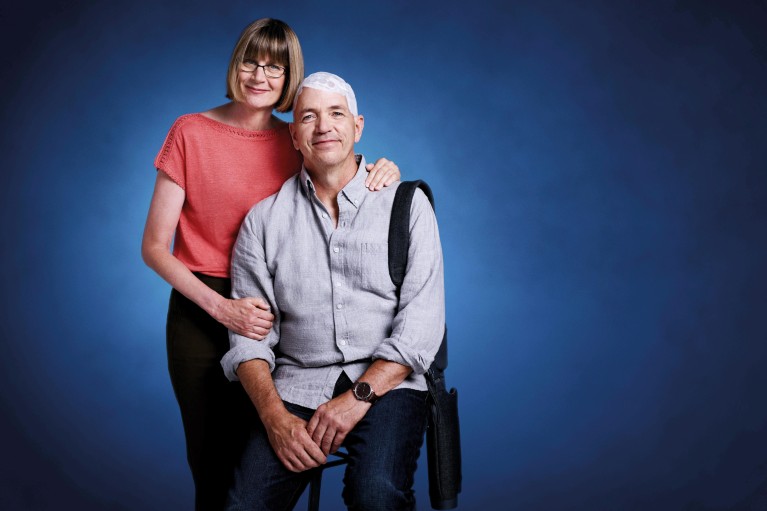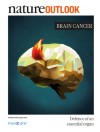Brian, who was diagnosed with glioblastoma multiforme, wearing the Optune device. Brian is pictured with his wife, Susan, in 2018. (Reproduced with permission from the patient)
My father was a handyman; he spent hours repairing stuff and making tools, toys and furniture. The thing about woodworking, as well as electrical engineering and photography, which I also enjoy, is that they require an incredible amount of resourcefulness, problem-solving and attention to detail. The question – whether you’re holding a camera, a piece of wood or a wire pinched between your fingers – is: ‘How can I make something well defined and functional out of the pieces I have in front of me?’ The solution isn’t going to be clear right away. The same can be said about living with glioblastoma.
I was on a business trip one weekend, walking around and thinking about an important software release. Next thing I knew, I was coming to, flat on my back with my feet on the sidewalk, my upper body on the street. Then, it was a whole bunch of emergency room doctors saying stuff above me that I really couldn’t follow. I’d had a seizure. The magnetic resonance imaging (MRI) scan of my brain showed a mass about the size of a golf ball behind my left eye. A ‘large tumour’, they told me. I informed them that unless I was going to die tomorrow, I had work to finish. The logical next step for me has always been to assess the pieces in front of me, visualize my goal and sub-goals, and determine the most efficient way of reaching them.
Four days later, after an appointment with a neurosurgeon and additional MRI scans, I underwent surgery to remove what we could of the tumour. While I was recovering, my glioblastoma diagnosis was confirmed. Neither my wife, Susan, nor I had heard about this cancer before, so during the days that followed, we researched all we could and discussed next steps with my healthcare team. After going through chemotherapy and radiation, I transitioned my care from a medical team at a big university hospital to my doctors at home. I was feeling okay physically, and my MRI results consistently showed stable images – no tumour growth or infections. At this point, we were just watching and waiting to see if my health changed. Then my radiation oncologist asked if I’d be interested in trying a medical device called Optune® for the treatment of glioblastoma multiforme (GBM) and walked me through the risks and benefits. I considered it an opportunity to hopefully extend whatever time I had left. I think I’ve always had the same attitude when it comes to treatment: I have nothing to lose.
It wasn’t a problem to adjust to the Optune backpack and get into the swing of using it. My goal is to exceed the recommended 18 hours per day on Optune. In fact, I’m in a little bit of a competition with a friend who is also using Optune – right now, he’s winning! I am still working full-time at a desk job and maintaining some of my hobbies. I teach classes at a woodworking store where I’m employed part-time. During the day I’m on batteries, and at night I use the power supply while I sleep. If I ever need to travel for work, Novocure ships supplies to my destination.
I’m still feeling positive. It’s hard knowing what this disease can do, but the worst part is watching my family suffer. I have decided to make my time here as positive as possible, so those around me can feed off that energy. If my father taught me anything, it’s that no matter the shape, size or amount of pieces in front of you, they will eventually fit together to create something special; it might just take time to find out how.


 Nature Outlook: Brain cancer
Nature Outlook: Brain cancer